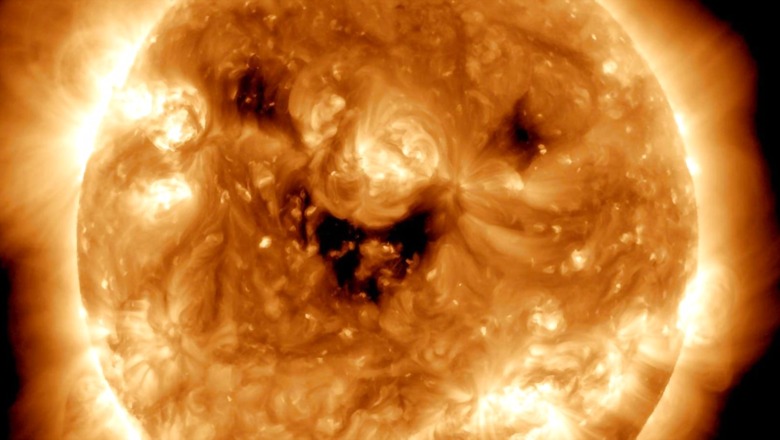
views
A NASA observatory captured a picture in which the sun appears to be “smiling,” with visible dark patches forming two eyes and an eerie smile.
These patches, NASA says, are actually the sun’s coronal holes which are only visible when the image is seen in an ultraviolet light, and cannot be observed by a naked eye.
The one of a kind image, taken by NASA’s space-based Solar Dynamics Observatory was shared on its social media on Wednesday, and has made the internet frenzy.
“Say Cheese. Today, Nasa’s Solar Dynamics Observatory caught the sun ‘smiling.’ Seen in ultraviolet light, these dark patches on the sun are known as coronal holes and are regions where fast solar wind gushes out into space,” the agency tweeted.
Say cheese! ????Today, NASA’s Solar Dynamics Observatory caught the Sun “smiling.” Seen in ultraviolet light, these dark patches on the Sun are known as coronal holes and are regions where fast solar wind gushes out into space. pic.twitter.com/hVRXaN7Z31
— NASA Sun, Space & Scream ???? (@NASASun) October 26, 2022
What are these patches?
Coronal holes are relatively cooler areas, as compared to their surroundings on the sun. They are also not as dense, and hence they are darker in appearance.
These holes can emerge on the surface of the sun at any time and can last between a few weeks to months.
Are Coronal Holes harmful to earth?
Coronal Holes contain magnetic field structures that can release streams of solar winds as well as charged particles at a speed of more than 1.6 million kilometers per hour.
At this speed, these winds or particles are powerful enough to reach our planet. Although Earth’s atmosphere acts as a shield and deflects solar winds activity, these winds can certainly disturb the atmosphere.
Going beyond the apparent smile, these coronal holes could also signify a solar storm hitting earth on Saturday, according to Spaceweather.com. This means a “triple stream of solar wind towards earth,” it said.
Solar storms are a mixture of eruptions of mass and energy from the Sun’s surface that can deform the earth’s magnetic field.
Due to this, the storms have the ability to increase the visibility of the polar lights, also known as auroras, in the northern and southern hemispheres.
If a strong solar wind reaches the earth, it can cause a change in the planet’s uppermost atmospheric layer, thus damaging radio and GPS signals.
Happy #SunDay! In the past week of space weather, there have been 3 solar flares, 23 coronal mass ejections, and no geomagnetic storms. The video below is from NASA’s Solar Dynamic Observatory, showing a smiling Sun near the end. pic.twitter.com/YVpM2vK0On— NASA Sun, Space & Scream ???? (@NASASun) October 30, 2022
The NASA Solar Dynamics Observatory regularly captures images of the Sun and monitor its activity.
As the photo was released a few days before Halloween (October 31), several reactions compared the image to look like carved Halloween pumpkin.
NASA also released the picture ahead of Sun Day, which falls on October 30, and said in the past week alone, there were “three solar flares, 23 coronal mass ejections, and no geomagnetic storms.”
Read all the Latest Explainers here















Comments
0 comment